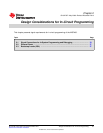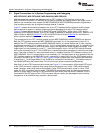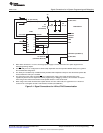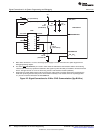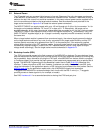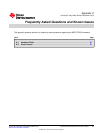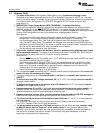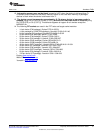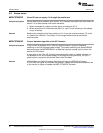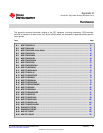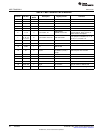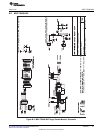
Hardware FAQs
www.ti.com
A.1 Hardware FAQs
1. The state of the device (CPU registers, RAM memory, etc.) is undefined following a reset.
Exceptions to the above statement are that the PC is loaded with the word at 0xFFFE (i.e., the reset
vector), the status register is cleared, and the peripheral registers (SFRs) are initialized as documented
in the device family user's guides. The CCE/CCS debugger and C-SPY reset the device after
programming it.
2. MSP430F22xx Target Socket Module (MSP-TS430DA38) – Important Information
Due to the large capacitive coupling introduced by the device socket between the adjacent signals
XIN/P2.6 (socket pin 6) and RST/SBWTDIO (socket pin 7), in-system debugging can disturb the
LFXT1 low-frequency crystal oscillator operation (ACLK). This behavior applies only to the Spy-Bi-Wire
(2-wire) JTAG configuration and only to the period while a debug session is active.
Workarounds:
• Use the 4-wire JTAG mode debug configuration instead of the Spy-Bi-Wire (2-wire) JTAG
configuration. This can be achieved by placing jumpers JP4 through JP9 accordingly.
• Use the debugger option "Run Free" that can be selected from the Advanced Run drop-down
menu (at top of Debug View). This prevents the debugger from accessing the MSP430 while the
application is running. Note that, in this mode, a manual halt is required to see if a breakpoint was
hit. See the IDE documentation for more information on this feature.
• Use an external clock source to drive XIN directly.
3. With current interface hardware and software, there is a weakness when adapting target boards
that are powered externally. This leads to an accidental fuse check in the MSP430. This is valid for
PIF and UIF but is mainly seen on UIF. A solution is being developed.
Workarounds:
• Connect RST/NMI pin to JTAG header (pin 11), LPT/USB tools are able to pull the RST line, which
also resets the device internal fuse logic.
• Use the debugger option "Release JTAG On Go" that can be selected from the IDE drop-down
menu. This prevents the debugger from accessing the MSP430 while the application is running.
Note that in this mode, a manual halt is required to see if a breakpoint was hit. See the IDE
documentation for more information on this feature.
• Use an external clock source to drive XIN directly.
4. The 14-conductor cable connecting the FET interface module and the target socket module must not
exceed 8 inches (20 centimeters) in length.
5. The signal assignment on the 14-conductor cable is identical for the parallel port interface and the
USB FET.
6. To utilize the on-chip ADC voltage references, C6 (10 ?F, 6.3 V, low leakage) must be installed on
the target socket module.
7. To utilize the charge pump on the devices with LCD+ Module, C4 (10 ?F, low leakage) must be
installed on the target socket module.
8. Crystals/resonators Q1 and Q2 (if applicable) are not provided on the target socket module. For
MSP430 devices that contain user-selectable loading capacitors, the effective capacitance is the
selected capacitance plus 3 pF (pad capacitance) divided by two.
9. Crystals/resonators have no effect upon the operation of the tool and the CCE/CCS debugger or
C-SPY (as any required clocking/timing is derived from the internal DCO/FLL).
10. On 20-pin and 28-pin devices with multiplexed port/JTAG pins (P1.4 to P1.7), to use these pin in
their port capacity:
For CCE/CCS: "Run Free" (in Run pull-down menu at top of Debug View) must be selected.
For C-SPY: "Release JTAG On Go" must be selected.
11. As an alternative to sharing the JTAG and port pins (on 20 and 28 pin devices), consider using
an MSP430 device that is a "superset" of the smaller device. A very powerful feature of the
MSP430 is that the family members are code and architecturally compatible, so code developed on
one device (for example, one without shared JTAG and port pins) ports effortlessly to another
(assuming an equivalent set of peripherals).
30
Frequently Asked Questions and Known Issues SLAU278F–May 2009–Revised December 2010
Submit Documentation Feedback
© 2009–2010, Texas Instruments Incorporated




